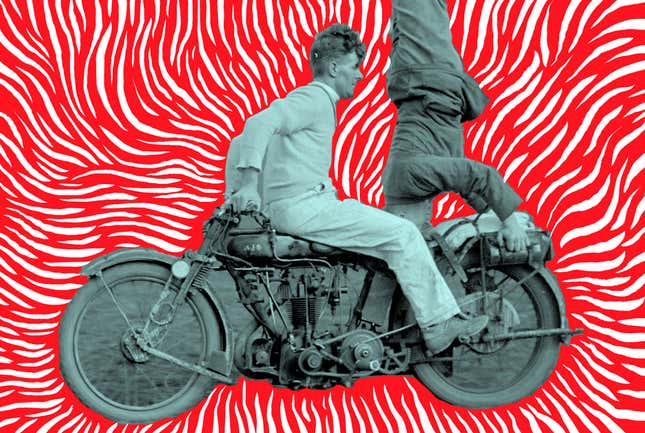
The problem is, most things are Good in inverse proportion to the degree to which they’re Fun. Broccoli is Good; Bacon is Fun. Taxes are Good; Casinos are Fun. Gyms are Good; Bars are Fun. You get the picture. But assuming, as I do, that all of us must live at least a little, few things are less Good and more Fun than a motorcycle. And no motorcycle is less Good and more Fun than a cheap one.
I speak from experience. I bought my motorcycle some years ago for $500—nearly a week’s pay for a teenage booze-cruise deckhand. I proceeded to paint it, wrench it, crash it, fix it, and use it as my primary means of wheeled transport for about three years. I cannot think of money I have spent better. Today it sits in a garage in Vermont, a testament to phlegmy carbs and small-scale electrical fires, calling me back like Danny from The Shining.
There are many Good things a motorcycle cannot do. A motorcycle cannot haul useful quantities of anything. A motorcycle cannot be used to bring your friends to the movies. A motorcycle cannot keep you dry in the rain, or especially safe in any sort of impact. A motorcycle cannot play your favorite songs. Sure, with a little know-how, a motorcycle can do all these things, but once you’ve put the engineering in, all you’ve built is a Fiat 500, which is neither Good nor Fun.

What a motorcycle can do is much more interesting. Being atop your transportation, as opposed to inside it, forces a certain mental presence. Flying down the road on the back of an incredibly dumb robot encourages you to pay attention to your surroundings, lest you become violently embedded in them. But this connection pays dividends. Your commute becomes an activity, your vehicle an extension of yourself, your world a bit more playful. All of this is to say, if you ride a motorcycle down a good road on a green day, you will smile. You should try it.
Getting Started
The first thing you’ll need is a motorcycle permit. Most jurisdictions will require you to take a short test, and provide a study guide to help you do it. Read this, in full, several times. You are essentially sitting on a sawhorse and encouraging the world to attack you at 60 miles an hour; you should have a grasp on the basics. Once you’ve demonstrated your minimum proficiency at booklet retention, you can begin to shop.
Most modern motorcycles are designed around a purpose. Cruisers make you look like a Son of Anarchy. Touring bikes help you go to Alaska with, or away from, your wife. Dual-sports and enduros let you ride to nature, then through it. Sport bikes are for going very fast. Standards are kind of alright at everything.
What Your Money Will Buy You
$0-1,000: DEATHTRAPS
At this price range, you’re mostly looking at used Japanese Standards, low-displacement cruiser-style bikes, and sports bikes with problems. Actually, everything here is going to have problems. You’re going to see a lot of bikes that need new batteries and carburetor cleaning, which are buyer-beware bywords for bikes that have been sitting forever and weren’t maintained in the first place.
I bought a Yamaha XS400 from a dealer who was patient enough to answer my questions when I had to, say, push the non-running bike to the shop, yell a question, and then run two miles to work in boots and a leather jacket. When I returned, he had it running again out of pure sympathy. What I’m saying is that you can get a deal here, or a project, but I’d recommend a hard look from someone with mechanical expertise. The same electrical failures, steering lockups, and soft brakes that are inconvenient in cars can mean a trip to the hospital in a bike.
$1,000-3,000: KNOCKAROUNDS
Here, you’ll find decently maintained or rebuilt UJMs, used sport bikes that aren’t time bombs, and cruisers that are.
$3,000-6,000: RESPECTABLES
This is the sweet spot, or would be if you weren’t buying a toy that could kill you for the price of a European vacation. Used cruisers, sport bikes, and standards in good mechanical condition abound. If you’re no mechanic and want something you can ride every day and fix mostly with wrenches, this is the category for you.
$6,000-10,000: BRAND NEW
Here you can buy a new Sportster or Triumph or sport bike. They’re new. They will have fewer or no quirks. Google, ask the dealer a lot of questions, and shop around on price.
$10,000+: LOOK AT YOU!
At this point, you’re doing one of three things: track racing, taking a sabbatical ride around the world, or trying to reclaim your masculinity. I can’t help with the first two, and my rates for the third are unreasonable.
Riding The Damn Thing
Once you have your bike, find a parking lot and learn to ride it. Five things control your bike—your weight, your throttle, your brakes, your transmission, and your handlebars. If you’ve ridden a bike and driven a manual vehicle, you should be able to parse together the basics. The only real trick is counter-steering. To turn the bike left, push, don’t pull the left handlebar slightly right to your front tire. The physics are long and complicated, but it helps with lean angle. For your purposes, focus on learning how to lean your weight and your hands will follow. (Note: A Motorcycle Safety Foundation beginner-riding course is also not the worst idea in the world.)
Gear is a personal preference. More is better, but also hotter, bulkier, and less convenient. If you’re wearing the wrong gear when you crash, you will regret it.
After you’ve got the basics down, expand your horizons by tackling longer trips, difficult terrain, or urban environments. You’ll be exposed to hazards—gravel, potholes, railroad tracks, distracted drivers, decreasing-radius turns, and target fixation are only the beginning. Eventually you’ll be opening the throttle and blasting out of hairpin turns, attacking mountain roads and eating PB&Js at the top.
Handling Small Repairs
If you have a bike that needs help, a Clymer manual is the closest thing you can get to a cookbook. Mine took me from helpless neophyte to hapless neophyte, which is a considerable improvement. For even the most useless mechanic, there are four things on your bike that you need to know how to keep an eye on: tires, chains, brakes, and carbs. If you have a fuel-injected, belt-driven bike, scale back accordingly.
Your chain and tires should get a visual inspection before every ride, and you should hard-stop your brakes within the first quarter-mile. It’s better to find out you’re low on fluid while near your house than behind a semi. Likewise for a weak chain or bald tire.
Deeper mechanical issues are going to be a case-by-case-basis. My only words of advice are to keep your workspace clean, try to remember how to put it back together, and don’t stop until you’re finished. Half a repair is worse than none.
Don’t Crash
They say there are two types of motorcycle riders: those who have crashed and those who will. I fall into the former category, but relatively painlessly. My crash was light: My shitty bike’s shitty headlight didn’t show a pothole while I was rounding a corner, my front wheel went in, and I went down. I walked out with a busted-up wrist, some road rash on my arm, and a shaken faith in my bike’s ability to hold the road. I got off lucky. I parked my bike in a lot and rode it home the next day with a new front tire and some bent handlebars. Some people end up sausage creatures.
The first thing about a crash is that you will regret all the gear you weren’t wearing. A heavy leather jacket would have protected me better than the canvas one I was wearing, and good gloves might have saved me some hand pain. If I had been going any faster and slid any farther, I would have cursed my blue jeans and work boots accordingly. If I hadn’t been wearing a helmet, I’d be counting to 20 with my toes.
The second thing, which I have fortunately never had to apply, is about “dumping” your bike, or deliberately going down to avoid an obstacle. The impulse is to stop your bike by putting the most friction on the ground. The flaws with this idea are several. Firstly, your brakes and rubber wheels tend to do a better job stopping than turning your bike into a metal-on-pavement ice skate. Second, you’re abandoning any hope of steering away from the obstacle. Don’t. Brake hard, steer hard, exhale, relax, and pray. Keep the rubber side down. This is the Bad part.
Samuel Wadhams grew up hard in Vermont and now grows soft in New York. He is not an expert on anything. Occasionally, he tweets here.
Image by Jim Cooke, photo via Getty.
Adequate Man is Deadspin’s new self-improvement blog, dedicated to making you just good enough at everything. Suggestions for future topics are welcome below.